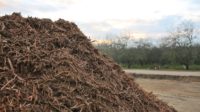California contractors will have an easier time disposing of treated wood waste (TWW) now that AB 332 was unanimously approved by the state legislature and signed into law by Gov. Gavin Newsom on Aug. 31.
AB 332 restores the Alternative Management Standard (AMS) for the disposal of TWW. The AMS, in place since 2008, allows preservative-treated wood waste to be disposed of in approved Class 2 and 3 landfills.
Peter Tateishi, AGC of California CEO, says the use of TWW, especially in items such as highway guardrails is important to the state’s construction industry due to potential job shutdowns.
“This was a really big deal for a lot of our heavy civil transportation contractors because our industry was literally at a point where people were wondering if they need to stop work at the beginning of 2022 if they can't actually dispose of this wood waste,” Tateishi said.
Tateishi says AB 332 allows contractors to use Class 2 and 3 hazardous waste landfills and it “jumps us back up from only two Class 1 landfills to about 50 Class 2 or Class 3 landfills that can be utilized.”
TWW comes from old wood that has been treated with chemical preservatives that help protect from insect attack and fungal decay while it’s being used. Examples of chemically treated wood include fence posts, sill plates, landscape timbers, pilings, decking, retaining walls and highway guardrails. The AMS expired last year when Newsom vetoed a bill that included its extension.
When that happened, "contractors were faced with extremely limited options” and faced increased costs for disposal, says Pat Kelly, chair of the California AGC's Highway & Transportation Division, and a representative of Granite Construction.
“Many projects were at high risk for shutdowns or scheduling changes, which often meant that workers could be sent home,” Kelly says.
After the AMS expired, disposal of treated wood was only authorized at a hazardous waste landfill until March 2021, when the California Dept. of Toxic Substance Control (DTSC) created a variance program where those disposing of treated wood could purchase variances allowing disposal in approved composite-lined landfills per the provisions of the AMS.
Due to an urgency clause included in AB 332, the law goes into immediate effect and all treated wood waste variances issued by DTSC since March 2021 are now inoperative and have no further effect.
“The passage of AB 332 is a huge win for homeowners, contractors, builders, environmentalists and our infrastructure,” said Dallin Brooks, executive director of Western Wood Preservers Institute in a news release. “The broad support for this bill reaffirms treated wood waste can safely be disposed while providing environmental benefits.”





Post a comment to this article
Report Abusive Comment